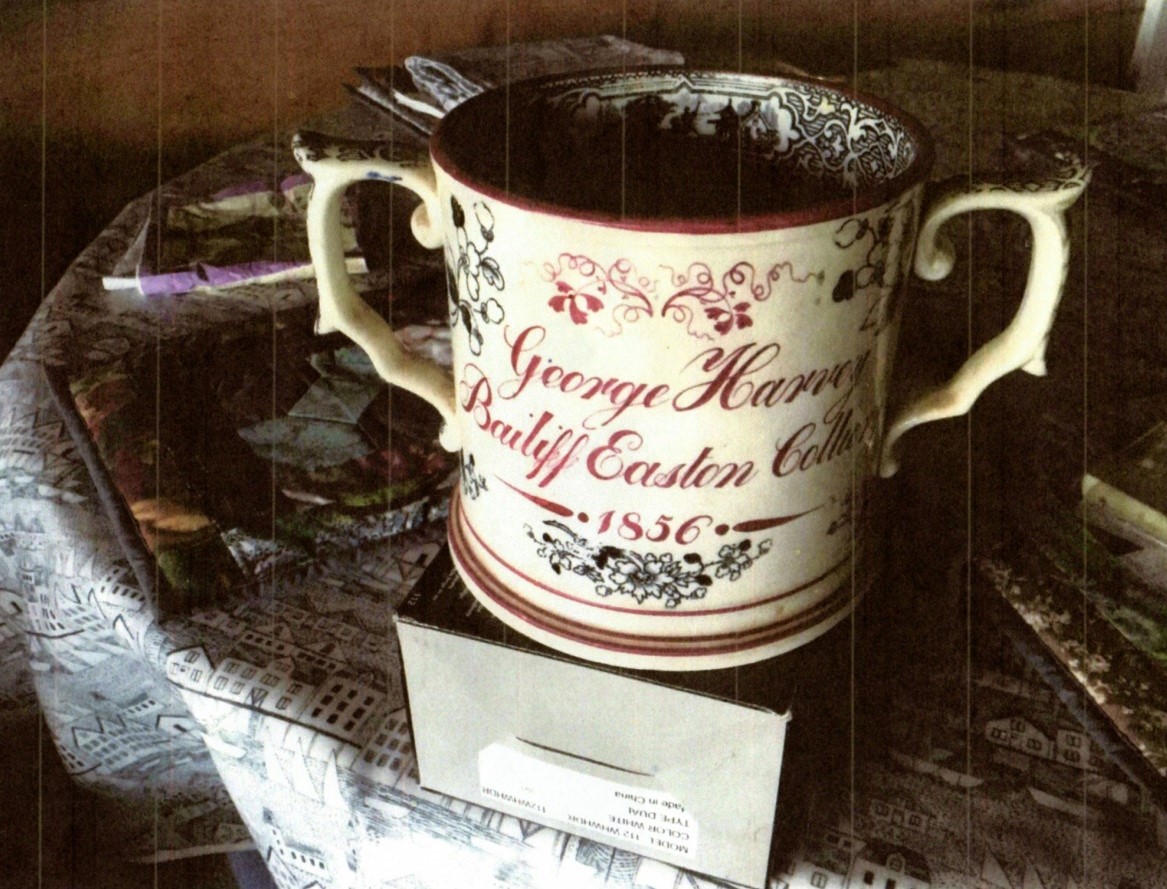
I first heard the story of the Harvey Jar from Becky Bull. The Jar is a treasured possession of the Harvey family of New Zealand. Becky saw it when she visited relatives in Wellington in 2016. It is a commemorative tankard presented to George Harvey of Easton, Bristol, though formerly of Newton St Loe, Somerset. Inside the jar a crumpled piece of paper has a note of the marriage of Aaron Harvey and the births of his children, Elizabeth, Harriet, George, Eliza and Jane.
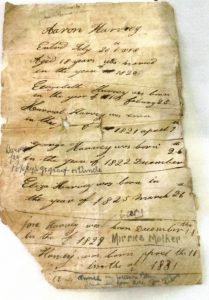 Aaron Harvey, a coal miner, from Newton St. Loe, Somerset (1799-1832) Aaron is Becky’s 4 x great grandfather. George Harvey (born 1822) is his son, named on the paper. Becky is a direct descendant of Aaron’s daughter, Harriett Harvey, George’s sister, born 1821. The New Zealand relative is a direct descendant of George’s younger sister, Jane Harvey.
Aaron Harvey, a coal miner, from Newton St. Loe, Somerset (1799-1832) Aaron is Becky’s 4 x great grandfather. George Harvey (born 1822) is his son, named on the paper. Becky is a direct descendant of Aaron’s daughter, Harriett Harvey, George’s sister, born 1821. The New Zealand relative is a direct descendant of George’s younger sister, Jane Harvey.
Aaron died of cholera in Newton St Loe in 1832. The entry in the parish register reads:
“Septr. 9th 1832, 33 years. The above Man was taken Saturday Morn. 8 o’clock Died Sunday Morning abt the same time of Cholera and was buried at 7 o’clock the same evening.”[1]

Aaron’s widow, Elizabeth Harvey nee Cooze (1802 -1875) married her second husband Henry Gregory Buck (1808-1879) who was also a miner from Newton St. Loe. The marriage took place at St Mary Redcliffe in Bristol on 5 October 1833. Both signed the register – though it is puzzling that Elizabeth is described “spinster”.
In 1841 Elizabeth and Henry Buck were living in Wellow, Newton St. Loe with Elizabeth’s children by Aaron: George, Jane & Ann; and her children by Henry Buck: Eli, Leah & Levi Buck.
Next door lived Moses Harvey, an adult, “aged 40” (adult ages in the 1841 census were rounded to the nearest 5 years) “a bailiff at the coalworks”, with his wife Mary, and their children William, 20, “engine attendant”, Richard, 15, coalminer, and five others, the youngest being Aaron aged 6.
When Becky first wrote to me, she wanted to know whether Moses might have been Aaron Harvey’s brother, though she could not find evidence for their relationship or their parents. Moses, the bailiff, later moved to Bristol and worked at Easton Colliery as did his nephew(?) George Harvey, of “the Jar”. From 1881 -1891 George Harvey’s nephew, George Richard Friend (son of Harriet Harvey; Becky’s 2 x great grandfather) also worked at Easton Colliery, Bristol as a time keeper. He lived on Easton Road, Bristol, until his death in 1913.
George Harvey and Becky’s ancestor, his sister, Harriet Friend nee Harvey, stayed in England but their mother Elizabeth Cooze/Harvey/Buck and her second husband Henry Gregory Buck decided to take the youngest Harvey children, Jane and Ann and their Buck children with them to New Zealand.
They sailed from Gravesend on the ‘Birman’ 13 October 1842 with Henry’s brother, George Green Buck and his family. They became founding pioneers of Wellington, N.Z and several other townships. After the extended Buck family departed to NZ, Harriett’s husband Isaac Friend (3 x great grandfather), was transported to the Swan River Colony (Perth) for 10 years for sheep stealing. He sailed in 1849 via the `Mermaid’ thus becoming a pioneering convict of the future capital of Western Australia.
Becky is not sure how the jar ended up in New Zealand; she is not aware of any of George’s direct descendants visiting N.Z
These are the questions Becky posed:
- Why was the jug presented to George Harvey?
- Why would this particular scene from Henry IV be painted onto the reverse of the jug?
- Were Aaron & Moses brothers?”
Aaron Harvey & Elizabeth Cooze were married on 15 October 1820 at Newton St. Loe after banns called in August at Walcot, Bath. Both parties signed the register, Aaron, unusually gave his occupation, “Engerneer” (sic). Their witnesses were Thomas Harrill, (the parish clerk) and two members of the Harvey family, Moses and Mary.
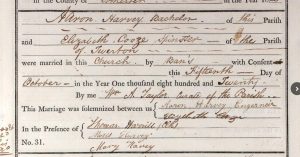
Moses Harvey & Mary Grant were married at St James, Bath on 27 April 1817, both parties signed the register before witnesses C. Russell and George Smith. Moses’ two signatures on Aaron’s marriage entry & his own marriage appear identical.
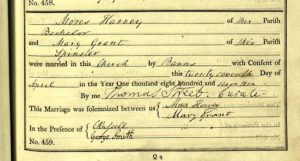 The fact that Moses & Aaron lived next door to each and that Moses witnessed Aaron’s wedding seems to me circumstantial evidence that the two were brothers. However, I have been unable to find baptism records for Moses and Aaron at Newton St. Loe or elsewhere.
The fact that Moses & Aaron lived next door to each and that Moses witnessed Aaron’s wedding seems to me circumstantial evidence that the two were brothers. However, I have been unable to find baptism records for Moses and Aaron at Newton St. Loe or elsewhere.
I looked for Moses in the 1841 census for Newton St. Loe. A specific place of birth is not shown in this census, only whether the subject was born in the county in which he/she was currently living, the answer being “Y” for Yes, “N” for No. Beside Moses’s entry was “N”. So I looked for him in the 1851 census, where the birthplace is shown and there he was – in Bristol, aged 55 (i.e. date of birth 1796), a coalpit bailiff, born at Siston, Gloucestershire. His wife was Mary, 53, born at Temple, Bristol and they had four adult children, of whom the eldest Moses, junior aged 24 and Thomas, 18, were both miners. Likewise I have not found a baptism for Moses at Siston.
As to the remaining questions – I assume the scene from Henry IV was a standard pattern. Perhaps a pottery expert can advise?
As to how the jar came to be in NZ, as the family had departed before it was made, I feel that there must have been physical contact between the families – despite Becky’s belief that there was no travelling between UK and NZ. Either somebody travelled to NZ taking the jar, or else someone from NZ came to this country and was given it. I cannot conceive it would have survived intact if posted or sent as freight.
George Harvey was almost certainly Moses’ nephew. In 1851 he was 28, living at Easton, Bristol, a coalminer, with his wife Mary, and two daughters. I suspect that 1856, the date of “the Jar” indicates family pride that he had become a “Bailiff” and the jar commemorates this. He was relatively young for such a responsibility. I can find nothing about George in the newspapers to correspond with this date but in the Western Daily Press of 31.8.1858 George Harvey is among the Colliery Agents and Overmen who received prizes from Bristol Mining School for their knowledge of underground work. He can be followed through censuses in the Easton area until 1881 when he is described “mining agent”; several of his sons were also coalminers. His obituary appears in the Western Daily Press of 5 March 1888:
“George Richard Harvey, 60, at his residence, the Royal Oak, Stanley Street, many years bailiff at Easton Colliery.”
I was also intrigued by the story of Isaac Friend, George Harvey’s brother in law, miner, convict and Becky’s direct ancestor. I followed his son George Richard Friend back through the censuses from 1891 (when he was a timekeeper at Easton Colliery), every ten years until 1851 when the little boy was by himself, a twelve year old pauper, an inmate of Keynsham Workhouse, an indication of the fate of children when their father fell foul of the law. This seems to suggest that his mother, Harriett and his sister Mary were both dead by this time, but I cannot prove it. It seems likely that Harvey family members rallied round and found George Friend a job at Easton where he worked as a coalminer until 1901, when the mines were in decline and he became a butcher.
Isaac Friend, aged 20, was a miner at Newton St. Loe in 1841, married to Harriett Harvey with children Mary, 2 and George, 6 months. In 1848 Harriet Friend witnessed the marriage of Aaron’s daughter Eliza Harvey:
 One year later Isaac Friend, (Taunton Courier18.7.1849) was convicted for the theft of a wether hog sheep “to be transported 10 years”. By 1860 he had served his time and was a gold miner at Jamieson, Victoria. He had a second family in Australia.
One year later Isaac Friend, (Taunton Courier18.7.1849) was convicted for the theft of a wether hog sheep “to be transported 10 years”. By 1860 he had served his time and was a gold miner at Jamieson, Victoria. He had a second family in Australia.
Becky says:
“I think that his son, George was probably better off in the new Keynsham Workhouse where I’m sure he got a better start in life than with Isaac who had been in the courts since he was a child.”
The Buck family thrived in New Zealand. Henry Buck (blacksmith) and his son Eli were some of the first miners to strike a claim in the newly discovered gold fields on the South Island. They were founding pioneers of Wellington and Palmerston North on the North Island.
There is one other gem to conclude this tale: readers of my book “Killed in a Coalpit” subtitled “Lives of the Kingswood Colliers” will be aware of the frequency of the name Harvey. Specifically, in the long report of the accident in 1838 in which my ancestor Jacob Pillinger and four others were killed, “Mr Harvey the bailiff” gave evidence. This was Isaac Harvey, who I suggest was another brother; I have followed him in the censuses and he was born in…….Newton-St-Loe!
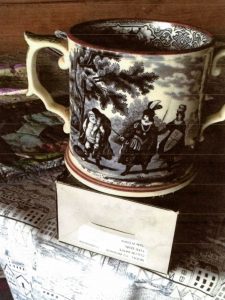
Harvey Jar (reverse view)
N.B. The lack of baptisms is a nuisance. The first item on the paper within the jar is a note that Aaron Harvey “Enter’d July 20th 1818 aged 18 years and was married 1820.” I believe the family was probably non-conformist and the date 1818 refers to when Aaron was received into a chapel. There was a strong non-conformist tradition among mining families. Often such chapel records are not deposited. For instance, I have no baptism records for my father and his many brothers and sisters who were Wesleyans.
Stop Press
As with all mysteries the situation is fluid as and when other information comes to light. Becky tells me
“I have since “discovered that several of the Buck family either emigrated to NZ, e.g. James & Hester Buck, siblings of Henry Gregory Buck, or visited the UK, e.g. George Green Buck, another sibling of Henry Gregory. Any of them might have carried the Jar from George Richard Harvey back to his mother Elizabeth Cooze/Harvey/Buck in Wellington to let her know he was doing OK; then it might have passed to his sister Jane Levi, nee Harvey. Will we ever know unless any letters turn up that specifically mention the Jar?”
Versions of this article appeared in back numbers of the Bristol & Avon FHS Journal & the Newsletter of South Glos. Mines Research Group.
[1] For more about the Cholera pandemic, see blog post “King Cholera in Bristol, 1832”.


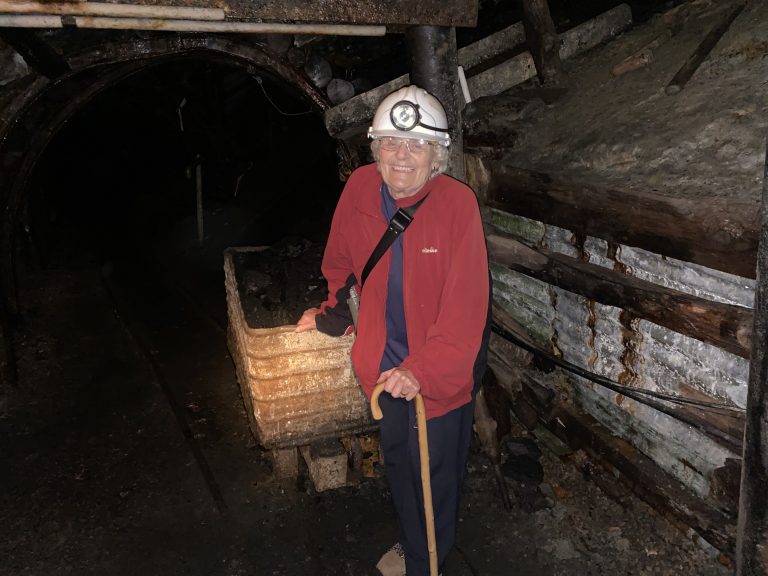

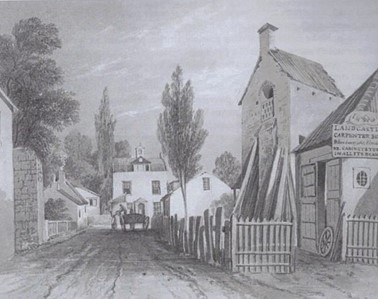
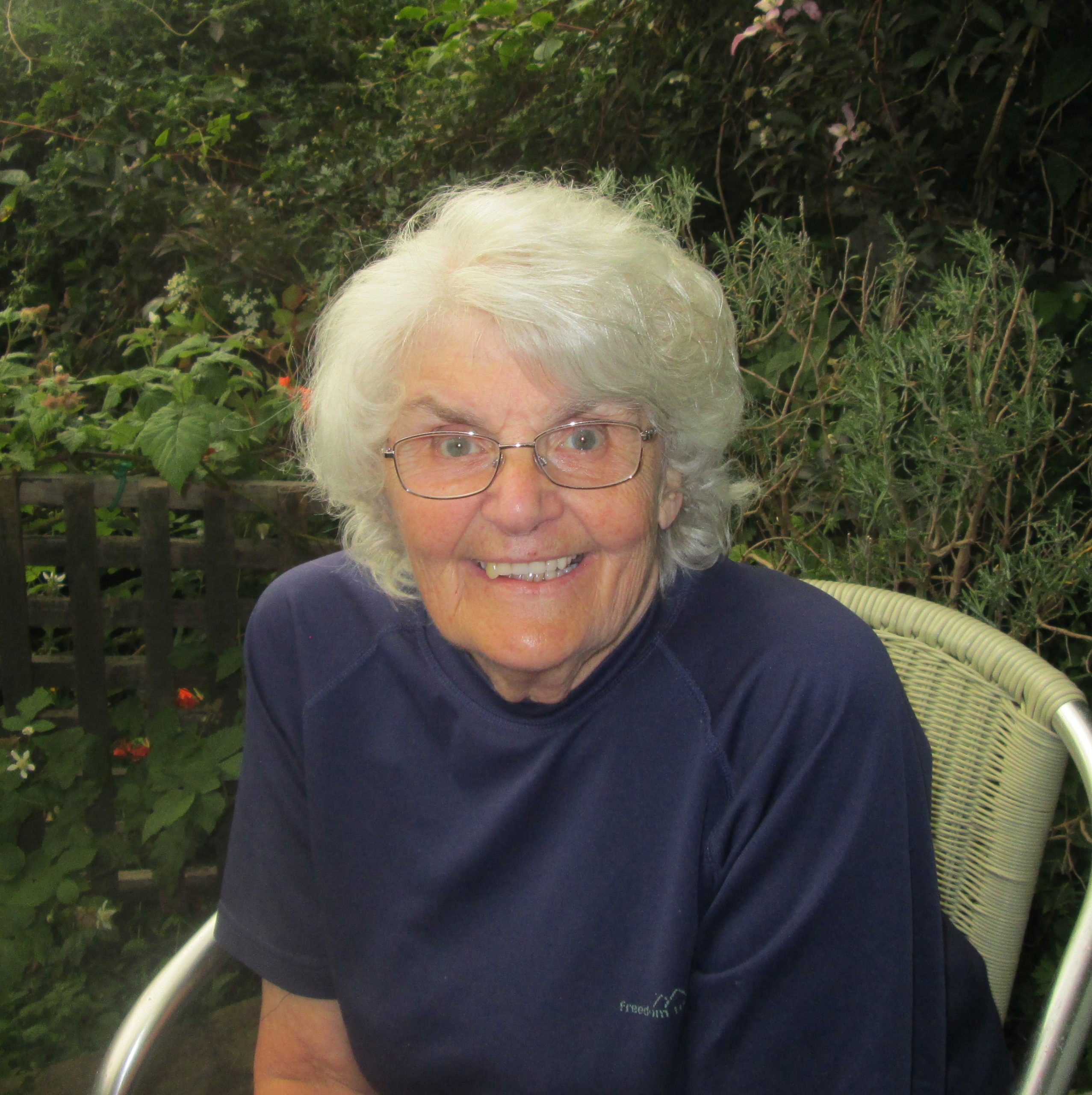


Leave a Comment